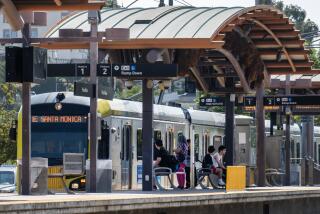PERSPECTIVES ON PUBLIC TRANSIT : Training the Cynics on Commuter Logic : Each new solution is greeted with skepticism, until it starts working.
Skeptical pundits have been honing their razor-sharp rhetoric since before Metrolink’s inaugural ribbons were cut. Yet despite the critics’ cacophony, commuters have embraced the system with an enthusiasm that has surpassed transportation officials’ expectations.
During Metrolink’s initial week, when commuters could ride free, ridership boomed to an average 10,000 per day. Once the fares took effect, ridership dropped to the current average of 3,300 per day, and critics were quick to forecast doom. But that level already exceeds, by more than 1,000 riders, what planners had projected for the start-up phase.
New commuter solutions are seldom introduced without derision. But the attacks rarely stem the tide of public acceptance if an idea’s time has come.
Take carpooling, for example. In 1973, when President Nixon implored the nation to use carpooling and mass transit to conserve resources during the energy crisis, critics here scoffed. After all, one car per commuter was the California way of life.
Transportation officials organized ride-sharing agencies anyway. With the help of employers, commuters and air quality regulators, they gradually transformed the region from the nation’s drive-alone capital to its current status as No. 1 in carpooling among the nation’s 10 largest metropolitan areas.
Today, nearly one in three of the region’s 6.8 million commuters either carpools or takes public transit to work at least once a week. One in five commuters carpools at least one day a week and that number is still growing. Clearly, gridlock is still a problem, but without carpooling, it would be worse.
The Blue Line light rail system is another example of how new transportation solutions can gain acceptance. In two years, ridership has steadily increased to 36,000 daily--more than the rate during its first two free weeks.
Metrolink ridership will no doubt increase as the system and its supportive network of buses, taxis and subways is enhanced. Before Metrolink was introduced, a survey indicated that nearly 800,000 drive-alone commuters would consider using rail at least once a week. With evidence like this, officials would be remiss to omit rail from the regional transportation plan.
More to Read
Sign up for Essential California
The most important California stories and recommendations in your inbox every morning.
You may occasionally receive promotional content from the Los Angeles Times.










